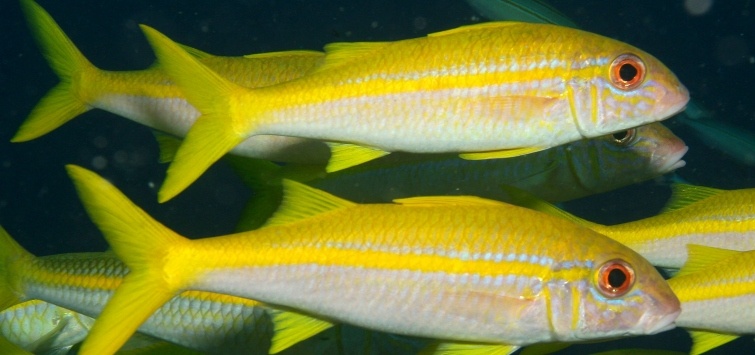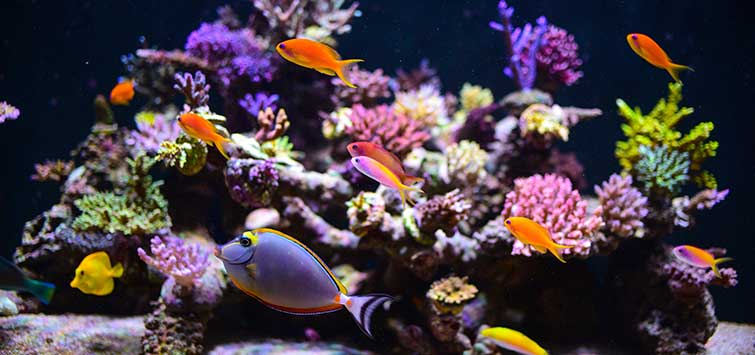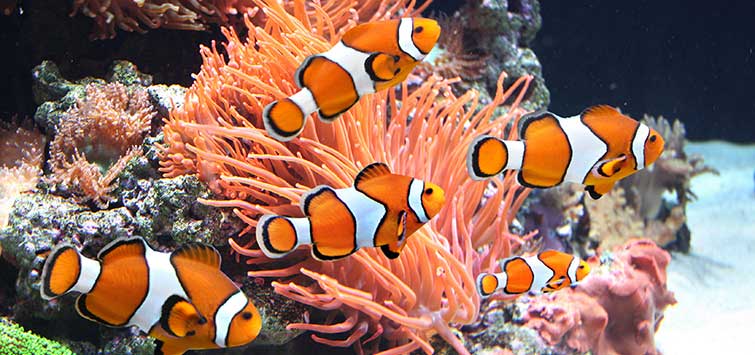A Look at the Goatfishes
Author:James W. Fatherree
There are over 50 goatfish species, several of which are regularly available to marine aquarists. While certain species can be reasonable additions to some reef aquariums, they are generally better suited for life in a large fish-only aquarium. In this edition of Reef and Coral Corner, I’ll share information about the goatfishes and why you may or may not want one for your own setup.
For starters, all of the various species of goatfishes are members of six genera in the family Mullidae. Most are found in the Indo-Pacific region, but others are found in the Red Sea, the Eastern Pacific, the Western Atlantic, the Caribbean, and the Gulf of Mexico, so you can find some type of goatfish pretty much all around the world.
Features that all goatfish species share include a somewhat cigar-shaped body that’s rather triangular in cross-section and a pair of long, thin barbels with taste buds. The barbels protrude from underneath a goatfish’s chin and can move around independently of the other to help the goatfish find food items buried in the substrate or hiding in rubble. They’re stiff and agile enough to move sand and small bits of gravel aside to get at the food once found, as well.
The food items they are searching for include all sorts of invertebrates that live in or on the substrate. Goatfishes eat shrimps, crabs, and other crustaceans, but they will also munch on small starfishes, brittle stars, worms, clams, snails, and even small heart urchins. That’s not all, though, as big ones will eat small fishes that live on the bottom, too—gobies and blennies beware!
Given that diet, it’s easy to see why these fish can be problematic additions to a reef aquarium, despite the fact that hobbyists occasionally purchase colorful juveniles for their reef tanks. Size can certainly be an issue, as well, with most of these fishes boasting record lengths of a foot (30 cm) or more, with some getting closer to 2 feet (61 cm) in length.
Aquarium Setup
Again, it’s clear to me that a goatfish really isn’t a good choice for the vast majority of home reef aquariums, unless some very thoughtful planning is done and the tank is quite large. Many goatfish species are indeed cool-looking, but like I said, they all get pretty big. A couple, if placed in an aquarium, will likely get no larger than 7 or 8 inches (18 to 20 cm) in length, but that’s still pretty big for most tanks, so even the smaller species shouldn’t be kept in an aquarium smaller than 125 gallons (475 liters) and 6 feet (180 cm) in length. Juveniles of larger species grow larger, of course, so you’d likely need an even bigger tank than that for them at some point, or you would have to find a new home for the fish.
Even in a tank of this size, there shouldn’t be too much rockwork, as there needs to be a significant area of open bottom covered with sand, or a sand-rubble mix, that’s a couple of inches (5 cm) deep at a minimum. An old-school setup with a wall of live rock going from end to end and just a strip of sand exposed at the front of the aquarium is not the way to go. That said, there should be enough rock in the aquarium to give a goatfish somewhere to hide and stay out of sight when it feels the need.
The sand is important, as most goatfishes will spend much of their time scooting about the bottom rooting around for food items. They’ll usually do a good job of keeping the substrate stirred up, and cleaner, in the process. Be aware that they can and often will move things around, though, sometimes including coral frags and small tridacnid clams sitting on the bottom.
Tankmates
If all that can be taken care of, the next thing to consider is livestock. Goatfishes are considered reef-safe in the sense that they won’t harm or eat corals and such, but they will eat many other things that are often found in reef aquariums. In fact, a goatfish in an aquarium will typically eat anything that’s meaty and will fit in its mouth.
Fortunately, their mouths are relatively small, so creatures like regular-size snails, large shrimps, and starfishes will be okay, but smaller things will likely disappear over time, such as little snails and worms living in the sand bed. As a goatfish grows in size, the largest thing it can eat will increase in size, too, so hobbyists have to be mindful of this and only keep a goatfish with motile invertebrates that are big enough to stay alive, or at least ones that won’t be missed if they get eaten.
Then there are fish tankmates. Overall, goatfishes are peaceful in nature and can be kept with anything that won’t act aggressively toward them or keep them from getting enough food at feeding time. However, they should not be kept with any fish small enough to eat. Again, blennies, gobies, mandarins, and such may be fine with a small goatfish, but they may be gobbled up by a larger one. I’d be wary of having damsels, chromis, or anything else of that size in a tank with a relatively large goatfish.
Feeding
As is the case with most fish, a goatfish’s natural diet would be pretty much impossible to reproduce in an aquarium over the long term. But they’ll usually adapt to aquarium fare without much trouble. Most will quickly learn to take bits of fish, shrimp, clam, and the like as long as they’re chopped finely enough for them to eat. Likewise, they’ll usually take brine shrimp, mysis shrimp, flake food, and pellet foods. In fact, one of the most popular items used for them is an appropriately sized sinking shrimp pellet food.
In the event that one doesn’t begin eating various fish foods, you will likely need to offer some live foods to get it started. Live brine or mysis shrimp may be costly, but they work well to get many such reluctant fishes eating in the aquarium. Over time, frozen food can be added in greater amounts along with the live food, and most fishes will make the transition.
Regardless of what’s used, do keep in mind that goatfishes are big eaters. They should be fed well, a few times per day. Three to four times is best, several hours apart if at all possible. Otherwise, they have been known to slowly lose weight and eventually die. Still, when frequently fed with an appropriate diet, they are considered quite hardy and are not prone to suffer from disease or other health issues.
I’ll also add that these feeding requirements typically mean only one goatfish should be kept per aquarium. Many do school, especially when young, and they’re peaceful fishes in general, but trying to keep several or even a few would mean feeding a large volume of food multiple times per day. If you have an aquarium system that can keep water quality high despite relatively large additions of food, then you should have no worries. Otherwise, stick with just one.
The only other thing to mention here is that many do learn to feed higher in the water column, away from the bottom, so they may begin to feed with other sorts of fishes, rather than just hanging around the bottom all the time. In fact, some have been known to dramatically change their behavior and spend their days actively swimming around anywhere from the bottom to the top of an aquarium, whether it’s feeding time or not.
Selected Species
With that covered, let’s finish up by looking at some species I’ve encountered for sale online or in shops, or that I’ve seen in someone’s aquarium. There are other species, but these are fairly representative of the group, and I’ve included the two most commonly offered. I’ve provided some basic information for each, including their maximum reported lengths, geographic ranges, and habits/habitats as reported by Fishbase.org, but keep in mind that any maximum reported lengths are basically record-setters, and very few individuals of a species will closely approach them even if well fed and kept in a relatively large aquarium.
Yellow Goatfish
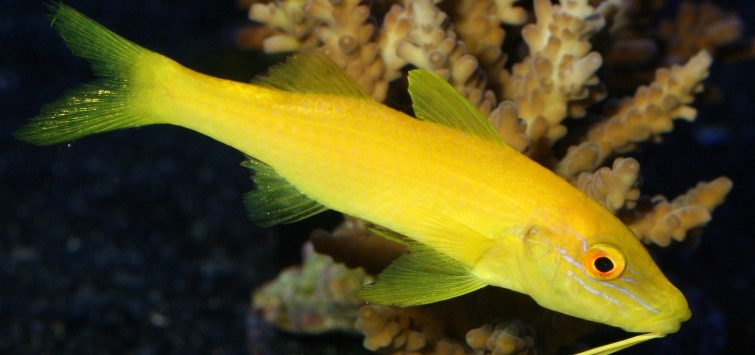
The yellow goatfish (Parupeneus cyclostomus) is also known as the yellowsaddle or goldsaddle goatfish, as most are solid yellow in color. This is one of the most commonly offered species. It is found in the tropical Indo-Pacific and Red Sea, and has a maximum reported length of almost 20 inches (50 cm). However, adults in the wild typically reach a full length closer to 14 inches (36 cm). Keep this in mind, as specimens are frequently sold at a size of about 2 inches (5 cm), but they won’t stay that size for long if healthy.
Juvenile yellow goatfish are typically found in schools, but adults live solitary lives, and they’re usually found in areas with coral cover, rocky or rubble bottoms on seaward-reef areas, reef flats, and in lagoons around reef areas.
Of all the goatfish species, this one seems to stand out as the one that oftentimes doesn’t seem to know it’s a goatfish when kept in aquariums. I’ve seen multiple cases of hobbyists reporting that it swims about in the water column acting like any other fish, rather than spending most of its time roving around the bottom.
Spotted Goatfish
The spotted goatfish (Pseudupeneus maculatus) is found in the tropical Western Atlantic, Caribbean, and Gulf of Mexico, and it has a maximum reported length of just under 12 inches (30 cm). However, adults in the wild typically reach a full length closer to 9 inches (23 cm). P. maculatus do not school, even as juveniles. Juveniles are typically found in seagrass beds, while adults are found over sand and rocky bottoms in reef areas.
I believe this is the only goatfish I’ve seen for sale that’s collected from "over here” in the Western Hemisphere, and I haven’t seen many. But they do show up from time to time and would be an especially appropriate addition to a Caribbean-species reef aquarium despite their less-than-impressive appearance.
Goldstripe Goatfish
The goldstripe goatfish (Mulloidichthys vanicolensis) is also known as the yellowfin goatfish. It is found in the tropical Indo-Pacific and Red Sea, and has a maximum reported length of 15 inches (38 cm). However, adults in the wild typically reach a full-grown length closer to 10 inches (25 cm).
Goldstripe goatfish tend to form large schools during the day, but they often disperse at night to feed over sand flats in lagoons and near seaward reefs. In fact, some of the largest schools of fishes I’ve come across in reef environments comprised hundreds of these fish.
Double-Bar Goatfish
The double-bar goatfish (Parupeneus trifasciatus) is found only in the tropical Indian Ocean, and it has a maximum reported length of almost 14 inches (35 cm). However, adults in the wild typically reach a full length closer to 11 inches (28 cm). Juveniles are found on reef flats, while adults form schools on occasion along rocky areas of lagoons and seaward reefs.
Unique in that it is the only goatfish species found in the Indian Ocean, P. trifasciatus is offered only on occasion by aquatics dealers.
Bicolor Goatfish
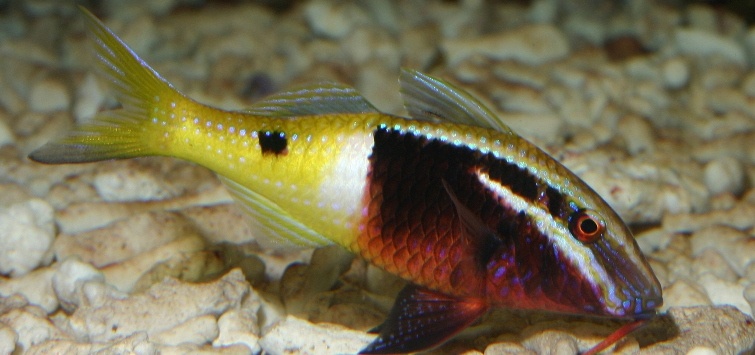
Lastly, we get to the bicolor goatfish (P. barberinoides), which is also known as the half-and-half or swarthy-headed goatfish. This is the most commonly offered goatfish species in the hobby. It’s found in the tropical Western Pacific and has a maximum reported length of just under 12 inches (30 cm). However, adults in the wild typically only reach a full length of about 8 inches (20 cm).
Juveniles are typically found in schools, but adults live solitary lives. They’re usually found in areas with mixed sand-, rubble-, and seaweed-covered bottoms in bays or lagoons around reefs.
Again, P. barberinoides is definitely the most popular of the goatfishes in the hobby, at least when it is available. Most specimens are sold at a size of 2 or 3 inches (5 to 7.5 cm) in length, with the largest I’ve seen being about 4 inches (10 cm). I don’t think I’ve ever seen one grow to more than 6 or 7 inches (15 to 18 cm) in an aquarium, either, so if you’re thinking about trying a goatfish, the bicolor is most likely your best bet.
See the full article on TFH Digital https://www.tfhdigital.com/tfh/mar_apr_2018/MobilePagedReplica.action?pm=2&folio=26#pg29

.png?h=595&iar=0&w=2781&hash=5FD5E69473BCC22199FBFA2FB71B6033)
